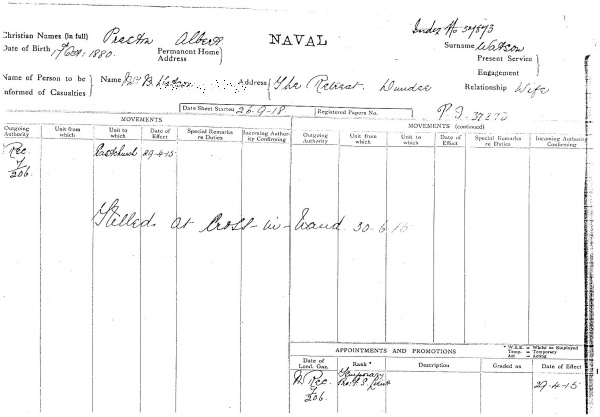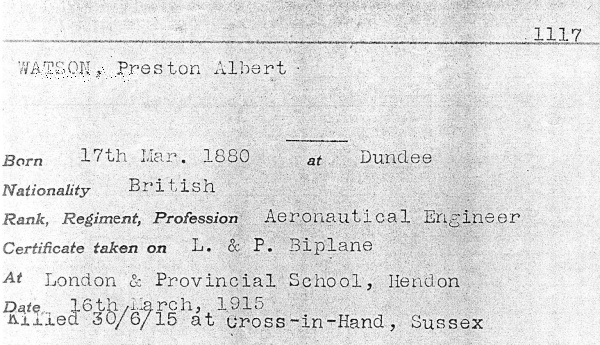In the preparation of this site a number of sources of reference were used, primarily books, magazine articles and newspapers. For the most accurate information on Preston Watson's flying experiments, mentions in Flight and The Aeroplane between 1913 and 1915 provide the best source of what he was actually up to, often in his own indisputable words.
After Preston's death at the end of June 1915 his name is absent from the scene until late 1953, when a small piece in Flight first draws our attention to James Watson's claim of powered flight before the Wrights. After then a few articles appear here and there, but these are more often than not rehashes of James Watson's original claims. This is because the aviation community paid scant attention to James Watson; his claims were not taken seriously, despite his unearthing eyewitnesses by the dozen from the Dundee and Errol region.
Of those who took note within the aviation “Establishment”, i.e. the Royal Aero Club and Royal Aeronautical Society, Charles Gibbs-Smith did the most work in fact finding about Watson, publishing his research in a number of authoritative volumes on the history of early aviation. It is his work that has provided the most comprehensive rebuttal to James Watson's claims and putting Preston Watson into context; therefore much of my own understanding of the Watson story is based on Gibbs-Smith's conclusions.
Those with an interest in aviation history accept without question Gibbs-Smith's work. Why wouldn't they? His books produced over forty years ago are still among the best and most accurate general histories of the subject available. His work stands out because he placed people and events into context like no-one had before.
Newspapers are always a good source of fiction; very few of the articles that have appeared on Preston Watson can be relied on for consistency with each other, let alone with the truth, yet they are good at pinpointing who said what when. In the Centenary of powered flight year (2003) a number of Watson articles appeared, mainly in the tabloid press, all having relied on information originally aired by James Watson that has been dispelled. But as they say in journalism, why let facts get in the way of a good story?
Almost all the newspaper accounts on Watson were written in Scotland, which is of no surprise really; few in the rest of the United Kingdom, or the World for that matter, have heard of him. For established organizations, such as the Dundee City Council and Dundee College to promote Watson, one of their own sons as the inventor of the aeroplane, when the claims of powered flight before the Wrights have been disproven is not acceptable, however.
Within the Royal Aero Club archive at the RAF Museum at Hendon is the record of Watson having achieved Certificate No.1,117. His Royal Naval Air Service record, what there was of it, is held by the National Archive at Kew. The accident record card noting Watson's cause of death is at the Fleet Air Arm Museum at Yeovilton.
Watson's original patents of 1907 and 1909 can be found at the Patent Office, London. These give considerable insight into Watson's thinking behind his novel approach to aviation, also revealing his understanding, or lack of, at the time of preparing his 1907 patent, on the subject. A copy of his book Power necessary in flight is worth glancing over if one can be located. Links to websites of interest are also listed below.
Note: this list is not exhaustive and only covers the main sources I used to research the text for this site, but it does illustrate the breadth of material available to the serious researcher.

Watson's casualty card recording the place of his death, but not how he died. As is on his Royal Aero Club Certificate card, his date of birth is recorded incorrectly. FAA Museum
Books
James Allan
Wings over Scotland: a history of the Scottish Aero Club; the first 75 Years 1927-2002 pp. 12 – 15 brief outline of fabled flights before the Wright Brothers in 1903, as well as known achievements
Charles H. Gibbs-Smith
The aeroplane: an historical survey of its origins and development (HMSO, London 1960): p.183; brief reference to lateral control system, pp. 208 – 213; outlines James Watson claims and counters them through his own research
Aviation: an historical survey from its origins to the end of World War II (HMSO, London 1970): p.71; name mentioned in reference to claims of powered flight before the Wrights
The invention of the aeroplane; 1799-1909 (Faber and Faber, London 1966): pp.174 - 175; brief description of aircraft constructed
The rebirth of European aviation 1902-1908; A study of the Wright Brothers' influence (HMSO, London 1974)
J. D. Gillies and J. L. Wood
Aviation in Scotland (Glasgow branch of the Royal Aeronautical Society): p.35; brief overview of known achievements
Michael H Goodall & Albert Tagg
British aircraft before the Great War (Schiffer, Atglen, PA 2001): pp.328 – 329; lists and describes each aircraft under sub-headings
Charles G. Grey
Jane's All the World's Aircraft 1916 (Sampson, Low, Marston and Co. Ltd, London, 1916): p.42; listed as holder of Royal Aero Club Certificate 1,117.
Peter Lewis
British aircraft 1809-1914 (Putnam, London, 1962): pp.516 – 518; lists and describes each aircraft under sub-headings
Lou McMahon & Michael Partridge
A history of the Eastbourne Aviation Company 1911 – 1924 (Eastbourne Local History Society, 2000): p.101; describes accident in which Watson dies – taken from Eastbourne Chronicle, 3rd July 1915
Grahame Ogilvy
Dundee, A voyage of discovery (Barbour Books), biased view of achievements based around testimony of James Watson
Ray Sturtivant & Gordon Page
Royal Navy aircraft serials and units 1911 – 1919 (Air Britain 1992): p.92; lists Caudron G.3 3266 as aircraft Watson lost his life in
Magazines
Aeronautics
February 1954, p.31; The Watson history, describes James Watson attending the Royal Aeronautical Society Jubilee Dinner with brief overview of Preston’s fictional career
December 1955, p.71; A pioneer in Scotland, letter written by James reaffirming his claims about his brother
The Aero
November 2 1909, p. 400; note about testing of Watson’s first aeroplane
The Aeroplane
February 24th 1915, p.185; under the sub-heading covering activities of the London and Provincial School, Watson is listed as “doing strts. alone.” (starts)
March 3rd 1915, p.209; under the sub-heading covering activities of the London and Provincial School, Watson is listed as carrying out “strts. or rolling”
March 10th 1915, p.234; under the sub-heading covering activities of the London and Provincial School, Watson is listed as carrying out “strts. or rolls”
March 17th 1915, p.258; under the sub-heading covering activities of the London and Provincial School, Watson is listed as carrying out “8’s or circs.” (figure eights or circuits)
March 24th 1915, p.286; under the sub-heading covering activities of the London and Provincial School, Watson is listed as carrying out “8’s or circs. alone” and that “Certificate taken... on March 16th in excellent style”
March 31st 1915, p.314; under the sub-heading covering activities of the Beatty School, Watson is listed as undertaking “extra practise”
April 14th 1915, p.366; under the sub-heading covering activities of the Beatty School, Watson is listed as “Pupils with instr.”
May 5th 1915, p.428; recorded as probationary Flight Sub-Lieutenant
May 26th 1915, p.538; listed as a new pilot in numerical order of RAeC pilot’s certificate (1,117)
July 7th 1915, p.7; obituary describing Watson’s work and death in the Caudron aeroplane
Aircraft Illustrated
February 2004, pp.72 – 75 The Wright to fly? Jon Lake, fictional account of Watson’s activities copied from other inaccurate sources, article covers claimants to first flight.
Air Enthusiast
July/August 2004, Issue 112, pp.58 – 63 First to fly? Preston Watson – fact and myth, Grant Newman, Examination of the myths and the truth surrounding Preston Watson’s aeronautical endeavours.
BBC News Online
December 12th 2003, Flights of fancy? Jonathan Duffy, short paragraph referring to claims of powered flight before the Wrights.
Flight
May 15th 1914, pp.510 – 512; written by Watson describes No.3 aircraft entered into Concours de La Securite en Aeroplanes competition at Buc, France, including an in depth description of the rocking wing for lateral control
July 3rd 1914, p.712; photograph of No.3 aircraft entered into Concours de La Securite en Aeroplanes competition at Buc, France with images of three other competitors
December 25th 1914, p.1235; Flight sub-Lt Watson listed as “solo circuits”
February 26th 1915, p.145; photograph of a group of pupils and staff at the London and Provincial School at Hendon, Watson fourth from right, p.146; lists Watson under London and Provincial School heading as “rolling”
March 19th 1915, p.196; paragraphs with references to Watson’s experiments with conventional control systems and fitting of floats to his machine
March 26th 1915, p.210; listed under Aviators’ Certificates as No.1,117
July 9th 1915, p.489; listed under Roll of Honour as killed (no date), p.497; paragraph noting his accident
December 25th 1953, p.832; Unhonoured and unsung? Watson’s brother James claims he built and flew an aeroplane six months before the Wrights
Fortean Times
December 2003: p.41; sidebar about flight claims, part of an article on pp.36-42 called "Wright or Wrong?" by Philip Jarrett, covering various first flight claims
Flugsport
24 June 1914, pp. 546 - 552; Der große Bewerb der "Sicherheit im Flugzeug" describes the Concours de La Securite en Aeroplanes competition at Buc, France with two images of Watson's No.3 and inclusion in a list of entrants yet to compete.
L'Aerophile
15 April 1914, p.177; short section with reference to Watson's No.3 at the Concours de La Securite en Aeroplanes competition at Buc, France with two images
1st to 15th November 1914, pp.404 - 405; two page spread on Concours de La Securite en Aeroplanes competition with three images of Watson's No.3
The Meccano Magazine
June 1957 No. 6 Vol. XLII, pp. 284 – 285; The first Flying Scot, did he fly before the Wrights? J. F. Riley, a largely fictional view of Watson’s achievements prior to the Wrights based on James Watson's work.
Pacific Wings
March 2009: pp. 32 – 35; The lamentable truth – The tale of Preston Watson Grant Newman, an overview of Watson's achievements and an analysis of James Watson claims
WW1 Aero – The Journal of the Early Aeroplane
No.196, May 2007: pp. 7 – 21; Preston Watson's Aeroplanes, Grant Newman, an in-depth examination of Watson's aeroplanes
Newspapers
Manchester Guardian, December 15th, 1953; article in which James Watson reveals flight-before-the-Wright claims about his brother.
Scotsman Weekend Magazine, Saturday July 16th 1961; Preston Watson: Forgotten Scottish air pioneer by a special correspondent
The Courier and Advertiser, Saturday October 27th 1984; Preston Watson – Scotland’s pioneer of flight by a “Courier” reporter
Daily Record, March 29th 1999; Flying Scot beat the Wright flight by Iain Ferguson
Daily Record, September 4th 2003; Mystery of the Scot who made the world’s first powered flight by Lisa Adams
Sunday Herald, December 14th 2003; The Flying Scotsmen by George Rosie
Papers
Charles H. Gibbs-Smith
Brief preliminary notes on the aircraft designed and constructed by the late Preston A. Watson (June 1957); overview of Watson’s aircraft from published articles and research carried out by the author.
P. A. Watson
Power necessary in flight (John Leng & Co. Ltd. Dundee, 1908); notes outlining author’s theories on aerodynamics
Patents
GB190723553 Flying machines
GB190900047 Improvements in flying machines
Website Links of interest. More will be added soon.
Scottish National Museum of Flight
